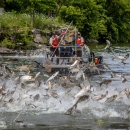States
WashingtonEcosystem
Coastal, WetlandThe Pacific Northwest has long been known for its tales of mythical and cryptic creatures, and while there is certainly something lurking in our waters, unfortunately it is not as elusive. The European green crab (Carcinus maenas) is an invasive species invasive species
An invasive species is any plant or animal that has spread or been introduced into a new area where they are, or could, cause harm to the environment, economy, or human, animal, or plant health. Their unwelcome presence can destroy ecosystems and cost millions of dollars.
Learn more about invasive species that has found its way into Willapa Bay. Native to the waters of the west coast of Europe to northern Africa, they established on the east coast of the United States in the 1800s, likely traveling across the Atlantic on ships. Efforts to curb their advances have been ongoing ever since. It wasn’t until 1989 that these resilient crustaceans appeared on the west coast in San Francisco Bay. They were first detected in Willapa Bay in 1998.
European green crabs are aggressive competitors with few natural predators in the waters of Willapa Bay, causing them to outcompete local crab species such as Dungeness crab. They also disrupt eelgrass beds, which provide critical habitat for a variety of species including migratory waterfowl, oyster and clam populations, and juvenile salmon.
Willapa National Wildlife Refuge is part of a large effort to trap and remove European green crabs from Willapa Bay, partnering with Washington Department of Fish and Wildlife, Washington Department of Natural Resources, and Pacific County Invasive Species Management. Shoalwater Bay Tribe and local shellfish growers play a large role in this effort, along with other local, state, and federal organizations. Washington’s European green crab catch count information can be found at Washington Department of Fish and Wildlife’s European green crab Hub. Along with removal efforts, the Refuge also operates two study sites with Washington Sea Grant to detect green crabs and identify the potential changes in the populations of native species once European green crabs are present.
Contrary to their name, these crabs are not always green! Their shells can appear mottled brown, dark green, light green, yellow or even orange. The most reliable way to identify a European green crab is by counting the spines. The shell will have 5 points, or marginal teeth, on each side. They only get up to 4 inches wide, but they have the attitude of a large crab (and a painful pinch!). They are often mistaken for native shore crabs like the hairy shore crab and purple shore crab; however, those crabs only have 3 spines. Interested in learning more about identifying crabs? Washington Sea Grant has a volunteer molt search program. Visit Molt Search to learn more about how you can help!
Per Washington State regulations, European green crabs are a Prohibited Level 1 invasive species. This means that, “live crabs may not be possessed, introduced on or into a water body or property, or trafficked (transported, bought or sold), without department authorization, a permit, or as otherwise provided by rule” (Washington Department of Fish & Wildlife). If a suspected European green crab is found, please report the finding at: Washington Invasive Species Council.
U.S. Fish and Wildlife Service has a Management plan for European green crabs, at: Management Plan for the European Green Crab.




